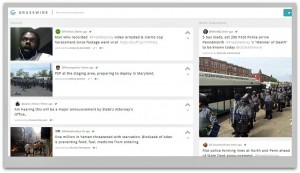The Savannah Morning News has implemented a program that gives its journalists a small monetary bonus for traffic growth, according to Steve Yelvington, vice president of audience at the newspaper.
The Morning News joins other publications, including Gawker, Forbes Media, The Daily Caller and The Oregonian, that tie some elements of compensation to online traffic growth.
Related story: “The Pay-Per-Visit Debate: Is Chasing Viral Traffic Hurting Journalism?”
Yelvington discussed the value of various news traffic metrics on Friday at the Journalism Interactive 2014 conference, where he appeared on a panel titled “Teaching the Social Metrics of News.”
The Morning News program, which is still in the experimental phase, rewards journalists with a $100 bonus if they meet their personal traffic “stretch goal”, which, in general, is a 5 percent increase from one to month to the next and is based on pageviews on the articles they produce, according to Yelvington.
“It’s really to give people another reason to pay personal attention to what resonates with the public,” Yelvington said in a follow-up interview.”Pageviews aren’t a perfect metric, but they are easy for people to understand.”
The paper started awarding bonuses based on pageviews about three or four months ago, Yelvington said, following the lead of the Amarillo Globe-News, which started a system of awarding bonuses based on reporter article traffic one year ago.
Since then, reporters at the Morning News have paid more attention to the timing of their posts, he said, and, it’s also changed the strategy of how public safety reporters write for the web.
“[They] don’t do [police] round-ups anymore,” he said. “They … [are] separate stories. Round-ups are great for print, but they are bad for online.”
If writers do not meet the 5 percent growth goal, there is no penalty, Yelvington said.
“It’s not a competition, but people are competitive,” Yelvington said. “If you’re not pitching in and contributing to the growth of the business, people are going to notice.”
Yelvington joined Susan Mernit, editor and publisher of Oakland Local and project director of Hack the Hood, and Joy Mayer, associate professor at the Missouri School of Journalism, on a panel moderated by Judd Slivka, assistant professor at the Missouri School of Journalism. (Further coverage of the panel can be found here.)
Mayer, at the panel, said she was “cautiously optimistic” about the idea of linking elements of reporter pay to their story traffic.
“Your effectiveness needs to go beyond, ‘Did your boss like this story?'” she said. “I think there needs to be some outward-focused success measurement.”
See previous articles on analytics in AJR:
AJR is the publishing partner for the Journalism Interactive 2014 conference, which was held April 4 and 5 in College Park, Md.
This story includes contributions from AJR News Editor Lisa Rossi








Leave a Comment